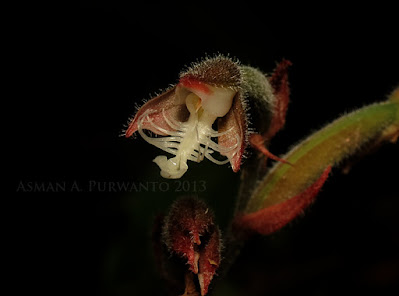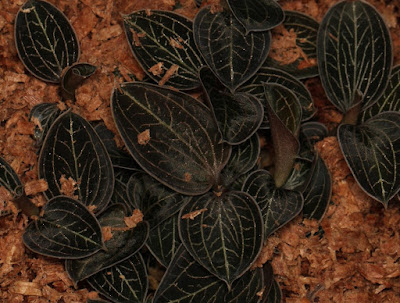Anoectochilus reinwardtii - Reinwardt's Anoectochilus is characterized by dark velvety green leaves with reticulate red or pink veining.
Anoectochilus reinwardtii, also called as Reinwardt's Anoectochilus, is a species of the genus Anoectochilus. This species was described by Carl Ludwig Blume in 1858.
DESCRIPTION OF ANOECTOCHILUS REINWARDTII - REINWARDT'S ANOECTOCHILUS
Anoectochilus reinwardtii is native to Thailand to Malesia. It is found growing in tropical rainforests and seasonal evergreen forests in Borneo, Jawa, Malaya, Maluku, Sumatera, Thailand at elevations of 200-1700 meters above sea level.
It is a miniature to small sized, hot to warm growing terrestrial species which reaching up to 20 cm tall with 4 to 6, ovoid to round, minutely apiculate leaves near the base. The leaves are 5 cm long by 3.5 cm wide, dark velvety green with reticulate red or pink veining.
Reinwardt's Anoectochilus blooms in the fall through later spring from the erect, white pubescent, to 15 cm long, 1 to 14 flowered inflorescence with triangular-ovate, single veined, glanular-pubescent bracts. The flowers are 2 cm across. The sepals are lanceolate, reddish and hairy on the outside, lighter and smooth on the inside. The petals are white and have same length as the sepals. The lip is white, extending beyond the sepals, and divides into 2 claws, each lined with 7 teeth on the lateral margins.
ANOECTOCHILUS REINWARDTII - REINWARDT'S ANOECTOCHILUS CARE AND CULTURE
Cultural information should only be used as a guide, and should be to be adapted to suit you. Your physical location; where you grow your plants, how much time you have to devote to their care, and many other factors, will need to be taken into account. Only then can you decide on the cultural methods that best suit you and your plants.
Light:
Anoectochilus reinwardtii needs a light level of 8000-15000 lux. The light should be well filtered and dispersed, and the plants should not be exposed to direct sunlight. Strong air movement should be ensured all the time.
Temperature:
In summer, the average day temperature is 27-29 °C, the night 21-22 °C, which gives a daily difference of 6-7 °C. In winter, the average day temperature is 26-28 ° C, at night 18-19 °C, with a daily amplitude of 8-10° C.
Humidity:
Reinwardt's Anoectochilus needs the humidity of 80-90% throughout the year. Too dry air has a negative effect on the development of the plant: its growth is inhibited, and the leaves begin to turn yellow and dry out. The higher temperature, the higher the humidity should be, and the higher the humidity, the more often and longer it is necessary to ventilate the room where the plants are contained, otherwise the probability of rotting and various kinds of fungal diseases. Good air movement is essential while the plants are in leaf and growing.
Substrate, growing media and repotting:
Anoectochilus reinwardtii are usually grown in shallow pots with good drainage, filled with a very loose, quickly drying ground, such as medium granulation bark or chopped tree fern fibers. Also, materials that loosen the substrate but often retain a portion of the moisture, e.g. perlite and cut sphagnum moss, are often added to such a mixture. Wood charcoal is also often added to ensure the air permeability of the substrate and protection against acidification.
The plants should be repotted when the substrate begins to decompose or grow out of the pots. If repotting is done at the time when new roots begin to appear, the plant will be accepted and rooted in the shortest possible time. These plants relatively easily reproduce from pieces of stem.
Watering:
Reinwardt's Anoectochilus in the phase of active growth should be frequently watered, but they should slightly dry out between waterings and you can never allow the substrate around the roots to be stale or soaked. When new growths reach maturity in the autumn, the amount of water should be gradually reduced.
Fertilizer:
During the active growth, the plants should be fertilized every week 1/4-1/2 of the recommended dose of fertilizer for orchids. You can use balanced fertilizer throughout the year, but can also use fertilizer with increased nitrogen content from spring to mid summer, and then in the late summer and autumn, use a fertilizer with a higher content of phosphorus.
Rest period:
Anoectochilus reinwardtii does not need a rest period to stimulate flowering, but in winter watering should be limited, especially those grown in colder conditions, but it is not allowed to dry excessively or remain dry for a long time. Fertilization should be reduced or completely eliminated until more intense watering starts in the spring.















COMMENTS